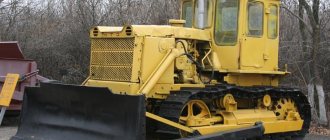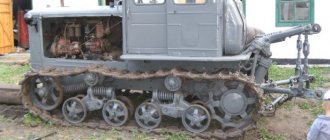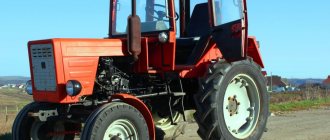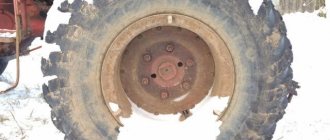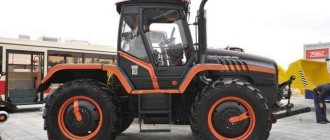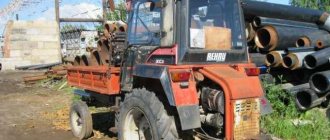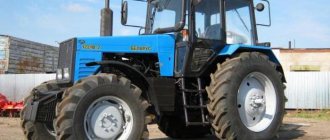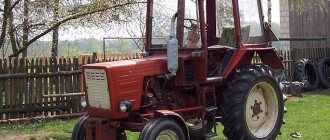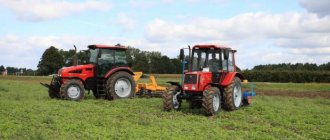The transition to a peaceful path was difficult for the Chelyabinsk Tractor Plant - from 1941 to 1946, the production of all civilian products there ceased. And the first conversion model of the tractor with an 80-horsepower engine turned out to be military-style tough and unpretentious.
With all the advantages of the “eighty”, which rolled off the production line before 1958, its design required improvement. This is how the S-100 tractor appeared, the history of which dates back to the purchase of a license for the American Caterpillar D6 in the 1930s.
Tractor S-100 and Caterpillar D6
It’s interesting that Sotka is not far from its predecessor. They were mainly distinguished by engine improvements. The old engine's speed was increased to 1050 per minute, the shape of the pistons was changed, the design of the valve mechanism was modified, the injection-exhaust cycle was slightly changed, the injectors and pump were modernized, the radiator was enlarged, and the fan was modified. The crankshaft received more reliable support bearings. This is how the KDM 100 engine turned out, producing a nominal 100 hp. and 92 - guaranteed.
During production, which ended in 1963, the chassis of the tractor was also modified - the road wheels and idler wheels received roller bearings instead of archaic sliding ones.
Tractor modifications
At the very beginning, the “weave” was combined with a DZ-53 bulldozer, in which the blade was controlled by a rope. Then it was modernized with a more modern hydraulic system. The new vehicle received the designation DZ-54. And fourteen types of attachments were already produced for it for use in various construction and road works. These were a stump remover, a brush cutter, a ripper, a stone remover, and a widener. Pile drivers, cranes and pipe layers were mounted on the T-100 chassis.
Reviews from ordinary tractor drivers indicated that the T-100 MGP modification had hydraulic equipment, a front linkage system, and instead of a winch, a rigid coupling device. It provided output mechanisms for connecting the power take-off shaft and the rear linkage system. Both of these modifications were produced as a swamp vehicle, the tracks of which had a wider cross-section - T-100 B and T-100 BG.
The letter “T” in the name indicated a pipelayer, which, instead of hydraulic mounted systems, provided fastenings for specialized units and devices. The T-100 MGP-1 tractor was produced in a lightweight version without a cab. The last modification of the “hundred”, produced in parallel with the new T-130, was the T-100 MZGP with hydraulic servomechanisms for controlling turns. And, perhaps, only she can still be found. And even buy it.
Possible faults
During operation of the machine, various types of malfunctions may appear. Most of them do not require serious intervention and can be eliminated in the shortest possible time.
- The car engine is unstable. There may be several reasons for this. First of all, you need to make sure there is fuel in the tank. The most common possible malfunction is a clogged fuel line or filter. Also, interruptions in operation may be caused by the fact that the tractor engine did not have time to warm up sufficiently. Accordingly, to troubleshoot problems, you need to warm up the engine, clean the fuel system and replace the filters.
- The engine began to knock. This problem can be solved by adjusting the valve clearances in the tractor.
- The brake bands get hot or the car brake does not work. Flushing the side clutches and adjusting the brakes will help here.
- Increased oil consumption. In this case, it is necessary to inspect the system for leaks and check the condition of the piston rings.
- Excessive smoke from the tractor exhaust pipe. Here the cause should be sought in the quality of fuel or water entering the system. If the engine is warm enough and the color of the smoke has not changed, it is recommended to replace the diesel fuel.
- The T-100 carburetor often fails. If the tractor malfunctions, it should also be checked.
Truth and fiction
Many years after the end of production of the tractor, its history and descriptions became overgrown with legends.
These legends are not always based on real facts. Let's sort it out in order: T-100 is another name for the S-100 model. Yes and no. These tractors are similar in design. This is easy to verify by comparing the technical characteristics of the S-100 and T-100, descriptions, dimensions and weight. The following parameters will be the same: - Traction force, which is 6000 kg. — The number of gears is five forward and four backward. — Base – 2270 mm. — Track – 1880 mm. — Ground clearance – 391 mm. — Fuel tank capacity – 235 l. — Specific pressure on the ground – 0.47-0.48 kilograms per square centimeter. But the KDM-100 engine, installed on the early model, turned out to be not very successful. The D-108 engine was chosen for the new tractor. It is more powerful - 108 hp. With. versus 100 l. s., and consumed less fuel - 175 g/l. With. h. versus 208 g/l. With. h. The launch was carried out using a P-23 starting unit running on gasoline. A close relative of the tank. There is an opinion that the design of the T-100 tracked tractor used technical solutions characteristic of Soviet tanks of that period. It's a delusion. The construction of ChTZ was carried out with the involvement of specialists from the USA, and proven Caterpillar tractors were used as basic models for creating the first models. To save time, components and assemblies were copied. This was not easy, since in America the inch system was used, and it was necessary to hastily recalculate the dimensions of the parts to the metric system adopted in the USSR. Despite the increased power, weight and dimensions, the design of the T-100 tractor uses the technical solutions of its predecessors - the S-60 and S-80, in which the ideas of Caterpillar can easily be traced. An example of reliability. The popular model of the Chelyabinsk plant cannot be called such. Components with a limited resource and require careful handling. Another thing is maintainability.
Attention was paid to it when developing the design. Most repair and maintenance operations can be performed without high-precision equipment and qualified personnel
This approach of the developers created the T-100M’s reputation as an indestructible vehicle. Inferior to models of imported equipment. For its time this is a very progressive design. In terms of technical characteristics, the T-100M tractor was at the level of world standards. Five years after the start of production, the model received a gold medal at an international exhibition. Not powerful enough. 108 l. With. obtained from the D-108 engine, whose displacement was 15.5 liters, do not look impressive by modern standards. For a tractor, it is not the power that is more important, but the torque parameters; everything was fine with that. The power unit, whose speed reached 1070 rpm, has a torque exceeding 800 N.m. The technical characteristics of the T-100M met the requirements of the time. Low comfort. The tractor suspension is made according to a semi-rigid design. This means that the springs were only in the front part, and at the rear the frame was attached to the crawler tracks through hinges. Forced ventilation of the bulldozer driver's workplace was carried out due to the fact that the engine took air from the cabin. Feedback from tractor drivers is clear: such a system became a source of loud noise. In this regard, the model was noticeably inferior to VT tracked tractors.
Specifications
Distinctive features of the T100 tractor are: a more powerful, improved engine with high torque, as well as an easy start function due to the presence of a P-23 engine. Some of the machines produced are still used in Russia, Belarus, and Ukraine. The cost of this model ranges from 150 to 300 thousand rubles (from 250 to 470 thousand hryvnia).
Weight and dimensions of T100
- The length of the T-100 is 4255 mm, height 3059 mm, width 2460 mm.
- The track created by the tractor is 1880 mm, ground clearance is 31.1 cm.
- Traction force at moderate speed is 6000 kg, in first gear - 9500 kg, in fifth gear 2000 kg.
- The higher the speed the car develops, the more the traction force decreases.
- The weight of the T-100 is 11,100 kg.
engine's type
- The engine brand of the T100 tractor is D108, diesel.
- Four-stroke, 4 cylinders, combustion chamber of an undivided type. The combustion chamber was located in the engine piston.
- The tractor power was 108 hp at a crankshaft speed of 1070 rpm.
- Cylinder volume 15.53 l.
- Engine weight - 2100 kg.
To make the diesel engine easy to start in the cold season, at sub-zero temperatures, engineers equipped the car with a P-23 engine powered by an electric starter.
The fuel tank capacity of the device is 235 l. The oil filter is equipped with a jet centrifuge. Starting the device has become easier due to a decrease in the fuel compression ratio. The torque was increased to 82 kgm.
Gearbox of the T-100 tractor
- mechanical;
- five forward gears, four reverse gears;
- three-way;
- reversible;
- bevel center gear;
- the drive gear is assembled into a block with the lower shaft;
- type of fastening of the driven gear - to the central gear shaft;
- rotary couplings are dry, multi-disc.
The speed range of the T-100 tractor was from 2 to 10 km/h when moving forward, from 2.8 to 7.6 km/h when moving backward.
Transmission and chassis
Clutch: dry, two driven discs. Clutch control mechanism: lever-cam. The clutch could be controlled from the driver's cabin using a lever.
Semi-rigid chassis. The chassis mechanism included tracked bogies (2 units), a balancer and the tracks themselves. The track chain was driven by a tension wheel and a special mechanism.
Cabin
At the time of the start of production (60s), the cabin of the T-100 tractor was one of the most comfortable among devices of similar purpose and traction class. The operator's soft seat, lighting, ventilation - all this made the work of the tractor operator comfortable. Contemporaries consider the air noise in the cabin caused by the forced ventilation system to be a minor drawback.
Control of the T-100 tractor
The tractor was braked using the onboard brakes. Turning was ensured by friction clutches and brakes. When driving the car, the driver felt quite a strong vibration, which was due to the type of suspension and the presence of a caterpillar track rather than wheels.
In agriculture, the model has not found wide use due to its low speed, but in industry, the “weaving” has gained recognition precisely because of its weight and smooth movement mode.
Reviews and prices
Since tractor production has ceased, only used equipment can be purchased. The cost of the car depends on the condition and additional equipment installed by the previous owners. The price of a tractor ranges from 150 to 500 thousand rubles.
Dmitry, Tver region
To clear forest plots, a T-100 manufactured in the mid-70s is used. The tractor is well suited for uprooting stumps and laying forest roads. Disadvantages include tight controls that require physical effort. In winter, the cabin is cold because there is not enough heat from the engine. Unscheduled repairs are rare; the machine requires timely maintenance.
Operating experience of the T-100 tractor: advantages and disadvantages
This type of tractor has not been produced for quite some time. Therefore, purchasing new spare parts is quite problematic. At the same time, it is not difficult to buy an already unused T-100 relatively inexpensively and gradually install entire parts on the operating “weaving”.
The main advantages of the tractor include:
the ability to easily install additional attachments:
- soil loosener, stump removal;
- equipment for work in agriculture, reclamation;
- pile driver for installation of piles, as well as a crane;
For aggregation it is possible to use more than 14 types of different equipment:
- relative ease of repair of this equipment;
- unpretentiousness to fuel, as well as other refueling containers.
The most important disadvantage is the lack of any comfort at work. Also, do not forget that as the tractor speed increased, the draft force decreased significantly - from 6 tons to 2 tons
This point must be taken into account when working on difficult soils, in the presence of attachments and a trailer.
Also, do not forget that with an increase in the speed of the tractor, the draft force decreased significantly - from 6 tons to 2 tons. This point must be taken into account when working on difficult soils, in the presence of attachments and a trailer.
Bulldozer with a fixed blade based on the T-100MGS tractor in operation
Another important advantage is the existence of a large number of different modifications. Due to this, it is possible to easily solve an extensive list of various tasks
It is the swamp rover that deserves special attention. It is on the territory of the Chelyabinsk region that there are a large number of formations of this type. What made the T-100B simply irreplaceable.
Transmission
The transmission of the 100 tractor model, with minor distinctive features from the previous version of the C 100 bulldozer, has a clutch in its design. The main advantage of this element is its ease of dismantling. In fact, the transmission acts as a separate unit, so the gearbox in this case is used of a mechanical type with the following stages:
- 5 modes – forward;
- 4 – back.
The 3-way type reversible gearbox uses a bevel center gear and a dry clutch for turns. The driven disk devices were equipped with friction attachments, which can only be controlled using certain servo levers. The semi-rigid undercarriage includes several crawler tracks as well as a balancing device.
Attachments
Depending on the modification, the tractor is equipped with a hydraulic linkage on the front or rear of the frame. A rigid rear hitch was used on some versions of the machine. An early version of the T-100 bulldozer was equipped with a cable control blade. To operate the mechanism, designated D3-53, a winch mounted on the frame of the machine was used. The later version of the D3-54 began to be equipped with a hydraulic blade drive. Bulldozers were widely used to prepare pits in conjunction with an excavator.
The tractor was rarely used as an agricultural machine due to its heavy weight and low speed. During the movement, a deep rut was formed, which made it difficult for combines and other equipment to move. Therefore, the tractor was used for plowing virgin lands and as a soil loosener.
Special equipment could be installed on the tractor base - pile drivers, drilling rigs. There were versions equipped with pipe layers.
Story
The tractor is a deep modernization of the S-100 tractor. Initially, the tractor was supposed to be called S-100M
(
Stalinets - 100 Modernized
), however, due to the eradication of Stalin's personality cult, it was renamed
T-100M
.
The transitional model from the S-100 tractor to the T-100M tractor is the T-108 tractor, produced from 1962 to 1965. (In fact, the T-108 tractor was never produced; T-108 is one of the names of the experimental tractor, which, upon serial production, was immediately designated T-100M). The first T-100M was assembled on October 9, 1963. In 1968, at an international exhibition, the T-100M tractor was awarded a gold medal. In 1977, production of the basic model T-100MZ
(Z - replaceable) began, using components of the T-130 tractor. The T-100MZ appeared due to the impossibility of quickly transitioning the plant to the production of T-130 tractors, thus releasing a transitional model, ChTZ was able to gradually master the production of new units.
The tractor is equipped with a low-speed four-cylinder four-stroke diesel engine D-108 with high torque, replacing the outdated KDM-100 engine (on the S-100 tractor). In the D-108 engine, the combustion chamber was moved inside the piston, while the KDM-100 had a spherical combustion chamber, consisting of a hemisphere at the top of the cylinder and a hemisphere in the piston.
The T-100M could be equipped with more than two hundred units, including bulldozers, scrapers, rollers, cranes and heavy self-unloading trailers.
Initially, the tractor was designed for use as part of the DZ-53 bulldozer with a rope-controlled blade. Later, the bulldozer equipment was modified through the use of a hydraulic system and received the designation DZ-54. 14 types of additional equipment were produced for the DZ-54 bulldozer: ripper, brush cutter, rock remover, stump remover, extenders, openers and others. The tractor was also used as a chassis for a pipe layer, pile driver and crane.
The tractor was distinguished by a high level of comfort in the cabin for the 1960s. The cabin had lighting, a soft seat, and forced ventilation by sucking some of the air into the engine from the cabin (although this solution led to increased noise in the cabin). To refuel the tractor, a vacuum device was used, powered by the energy of exhaust gases, allowing refueling from containers located below the level of the fuel tank. Its volume was 235 liters.
The T-100M tractor was widely used on Soviet construction projects in the 1960s–1980s (both large and small). Some machines of this type are still in operation (about 150 copies were in use in Hungary in 2006). The name T-100 actually became a household name for later models such as the T-130, T-170 and T-10. In turn, the T-100M tractor was often traditionally called the S-100.
The D-108 engine of the T-100 tractor is widely used on other types of construction equipment (compressor stations, diesel generators, as well as on excavators of the E-10011 family and its modifications).
The tractor was also supplied to agricultural enterprises, but was not widely used there due to its too low speed compared to specialized agricultural tractors.
DESCRIPTION AND PURPOSE
The T 100 was one of the most common bulldozers of the tenth traction class in the USSR in the second half of the 20th century. The model has been used in many industries throughout the country. The equipment was a deep modernization of the S 100 tractor and was originally supposed to be called the S 100M. The series was produced by the Chelyabinsk Tractor Plant from 1964 to 1977. The main version was equipped only with a blade and had a huge margin of safety. There were other modifications:
- T 100M – bulldozer with a winch without the ability to install rear attachments;
- T 100MB – analogue of T 100M with wide shoes;
- T 100MGP – version for use in industry and construction. It was distinguished by the ability to install front and rear attachments;
- T 100MBG is an analogue of T 100MGP with wide shoes for use in marshy areas.
There were other models (more than 20 varieties). The T 100 was considered a universal machine and was used in various directions: for felling forests, preparing building areas, building roads, cultivating agricultural land, cleaning areas and performing other operations.
It is noteworthy that the production of the T 100 ended quite a long time ago, but certain versions of the bulldozer are still in use today. High traction force, ease of repair and operation, unpretentiousness make the model an excellent assistant in any operation.
This is interesting: Shantui sd32 bulldozer: technical characteristics and fuel consumption
Creating a model
The industrial Soviet tractor, like many other types of equipment in those days, named after I.V. Stalin S-100, underwent major changes in the early 60s of the 20th century. First, the T-108 modification appeared. It was released for only three years. In 1964, the plant began producing “weaving”. And just four years later, the T-100 tractor won a gold medal at an international exhibition.
The heavy tracked vehicle was intended for industry and construction work. It was designed as a bulldozer with a rope-controlled blade. Later, it was decided to modernize it to use a variety of attachments. Unlike its predecessor, which had only two modifications, fourteen types of special equipment were produced based on the tracked T-100.
“Sotka”, as an industrial tractor, belonged to traction class 10. By the way, the modern wheeled T-25 (100% universal tractor, as it is proudly called) belongs to traction class 0.6. This category is determined by the maximum force that, under certain strictly established conditions, a wheeled or tracked vehicle can develop.
Price of a used tractor T-100
Today, purchasing a T-100 in working condition is quite problematic, but still possible. The cost of a tractor of this type is influenced by a large number of different factors. This is the year of manufacture, current technical condition, availability of registration documents and much more. An important factor is also the modification of a particular tractor. The most expensive models are those equipped with hydraulics and all kinds of attachments.
Often, when selling, the year of manufacture when a given tractor was not produced is indicated. This usually indicates that a particular tractor model has been mothballed for some reason since its assembly. The year of commencement of operation is indicated. For example, 1999. But in each case, you need to carefully examine the model before buying it. This will avoid wasting money.
Tractor driver's cabin
The T-100 cab is located at the rear of the vehicle behind the engine. It is located on a rigid frame. The cabin is equipped with a soft seat, as well as lighting and ventilation systems. It has a heating device.
For its time, it was a fairly comfortable workplace, despite the fact that all the devices create a lot of noise. But today such conveniences, in comparison with modern technology, seem like a relic.
Cabin of the T-100 tractor inside
Related video: Bulldozer T-100
Purpose of the T-100 tractor
The main area of application of the T-100 tractor planned by the developers was to work in combination with the D3-53 bulldozer, but later the equipment for the bulldozer was modified with a hydraulic system. A lot of additional equipment was produced for the D3-54 bulldozer model (a more advanced version that followed the D3-53), for example, a brush cutter, a device for uprooting stumps from the ground, a stone remover, a soil loosener, soil dredgers and more.
Tractor T-100
The T-100 tractor also served as a pipe layer and, in some cases, a crane. Thus, the purpose of the tractor was more industrial than domestic. For planting and collective farm work at that time, lighter, more maneuverable models were used, the control of which could be mastered by any person. Thanks to its heavy weight of 11,100 kg. The equipment was used in forestry work, construction, and industrial enterprises.
Development and release
The T-100 tractor, which received the short sonorous nickname “weaving” among users, is one of the most popular models of crawler tractors produced in Soviet times. The model was released between 1963 and 1983. Manufacturing plant: Chelyabinsk Tractor Plant. The prototype of the T-100 was the T108 tractor, which was produced in production under the name T100M.
The device has a wide range of uses and can be combined with many types of additional equipment, for example, bulldozers, heavy-duty self-unloading trailers, cranes, rollers, and scrapers. The T-100 can also work with conventional agricultural equipment, such as a harrow, seeder, potato digger, etc.
DT-90
An agricultural and construction crawler tractor, built on the basis of model 75. The full name of the machine is DT-90P. The tractor is equipped with an in-line 4-cylinder diesel engine D-440. The engine is equipped with a modified cylinder head adapted to install a turbocharger. The cooling system is liquid, with forced circulation and a thermostat. The engine develops a power of 95 hp, while providing a torque reserve of at least 35%.
The tractor uses a mechanical 7-speed gearbox equipped with a stern output of the power take-off shaft. As standard, the shaft has a rotation speed of 540 rpm. There are machines equipped with a shaft that provides a rotation speed of 1000 rpm. The plant produced such configurations on a separate order. The chassis consists of 4 road wheels, interlocked in pairs on bogies. The drive wheel is located at the rear, and a drive roller is installed at the front, which is used to tension the track.
The DT bulldozer is equipped with a blade, which is controlled by a hydraulic cylinder located in front of the radiator. The push bars are installed on an axle mounted on the tractor frame between the undercarriage bogies. The operation is controlled by the operator from the cabin, in which a hydraulic distributor is installed.
The DT-90P vehicles use a frame-type metal cabin. To install the cab on the chassis, rubber cushions are used to reduce vibration load. The equipment includes an air heater connected to the cooling system. In summer, the air in the cabin is cooled using an evaporative device installed in the ventilation system. The side walls are lined with soft material that absorbs sound and further reduces vibration.
Tractor T-100: technical characteristics
The T-100 was the product of a modification of the industrial Soviet tractor S-100. The main changes affected the cabin, engine, hood shape, replacement of electrical equipment and track mechanism. Several configurations of the car were available to the consumer. Later, the manufacturer released a model line of modified equipment for special work. The basic version of the T-100 is a general purpose tractor. Machine type: crawler tractor.
Engine
The T-100 tractors were equipped with the D-108 engine. The unit became the basis for the processing of previous models. The four-stroke four-cylinder engine featured an integral combustion chamber design, which was placed directly in the piston. The rated power of the car was 108 hp. and was achieved at a crankshaft speed of 1070 rpm.
The working volume of the T-100 cylinders was 15.53 liters. The diameter of one cylinder out of four was 145 mm, the piston stroke was 205 mm. The power unit had a mass of 2100 kg. For particularly difficult conditions, the manufacturer has provided at least 10% torque reserve. For starting in the cold season, the diesel engine was equipped with a P-23 starting engine with an electric starter. To meet the power requirements of the power unit, a fuel tank with a capacity of 235 liters was installed on the machines.
The T-100 starting engine began to be used on industrial machines for the first time. The design of the main engine of the D-108 also differed from the design of its predecessors. In the engine injectors, instead of one spray hole, they began to make five. The Chelyabinsk plant added a jet centrifuge to the oil filter.
The reduced compression ratio in the new D-108 made it easier to start the machine. Maximum torque was increased to 82 kgm. Increased power of the power unit was achieved due to improved mixture formation and fuel combustion in the piston crown chamber.
Transmission and chassis
The T-100 transmission was not very different from the similar unit of the predecessor S-100. Here, a clutch was used, installed as a separate, easily dismantled unit. The clutch is a dry single-disc with two driven discs with a lever-cam control mechanism. A special lever was installed in the driver's cabin to control the clutch.
The gearbox with a mechanical shift system had five forward gears and four reverse gears. Three-way gearbox, reversible. The central gear is a bevel gear, the drive gear is made in a single unit with the lower shaft of the box. The driven gear was attached to the flange of the central gear shaft.
The rotation couplings had a dry multi-disc device. The driven disks were made with friction linings, which were controlled by servo levers. Using a transmission and engine, the T-100 tractor could move in a speed range of 2.36-10.13 km/h forward and 2.79-7.61 km/h backward.
The running mechanism of the semi-rigid type machine consisted of two tracked bogies, a balancing device and tracks. Welded trolleys with a welded box-section frame. The track chain was installed on the support and support rollers and was supplemented with a tension mechanism and an idler wheel. The chain consisted of individual links secured to each other by bushings and pins. Track shoes with a special profile were attached to the links. The balancing device was a spring plate with two smaller stabilizing springs.
Cabin
The cabin of the T-100 tractor was installed on a rigid frame. The only difference between the cabin and the previous S-100 model was its shape. For its time, the tractor was considered quite comfortable. There was lighting inside the cabin and a soft driver's seat was installed. Also, the T-100 was equipped with a forced ventilation system, which, however, led to increased noise in the cabin.
dimensions
- length - 4255 mm;
- width - 2460 mm;
- height - 3059 mm;
- track - 1880 mm;
- length of the supporting surface of the tracks - 2370 mm;
- ground clearance - 331 mm;
- specific pressure on the soil - 0.47 kgf/cm2;
- specific metal consumption - 102.7 kg/hp;
- rated towing force - 6000 kg.
The T-100 tractor had a weight in the design position of 11,100 kg. The maximum towing force of the car was 9500 kg in first gear. As the speed increased, the traction force decreased. In the last, fifth gear, the tractor produced a force of 2000 kg.
Engine
The power of the power unit of the T-100M tractor, the first sample of which was assembled on October 9, 1963, was 108 hp. Engine model - D 108, type - 4-cylinder 4-stroke. This engine was more economical in comparison with the one installed on the previous model: specific fuel consumption decreased to 173 - 175 g/e.h.p.h. In particular, this was achieved thanks to the introduction of mixture formation with direct fuel injection. Pre-chambers were no longer used in the engine design, and injectors began to be installed directly into the cylinder heads (special bushings were provided for this). The function of turning off the diesel supply to the second and third cylinders when switching to idle helped to further reduce fuel consumption.
Let's talk about other features. Since the combustion chamber was now located at the bottom of the piston, the fuel injection pressure had to be increased to 200 kgf/sq.cm. Previously, a spherical combustion chamber was installed, one of the hemispheres of which was located in the upper part of the cylinder, the second in the piston.
The engine compression ratio was reduced to 14. The valve mechanism parts were also modified. The starting engine, called P 23, was equipped with an ST 204 starter.
In the future, the D-108 engine was widely used in the design of other equipment, for example, in the production of compressor stations and diesel generators. It was also equipped with E-10011 excavators.
Specifications
The multifunctional crawler tractor has ideal dimensions for its traction class: 4650×1950×2840 mm. The T-100 base has a length of 252 cm. The ground clearance is 371 mm.
Tractor T-100M
The ground clearance is 371 mm. The weight of the base tractor is 11 tons! If you install additional equipment, the weight will be even greater.
Engine
The entire range of T-100 tracked tractors is equipped with a four-stroke D-108 engine with a volume of 15.5 liters. Its power is 108 hp. The crankshaft rotation speed is 1070 rpm.
The engine starts using a simpler P-23 gasoline engine with an electric starter. This circuit allows you to prevent “cold start” when operating in areas with cold climates. A fuel tank of 235 liters allows the machine to be operated for a long period of time without refueling.
Transmission
The gearbox is of a mechanical type with 5 steps for driving forward and 4 in reverse. These models do not differ in high speed of movement. It can reach a maximum speed of 10 km/h.
Chassis and transmission
The frame of the crawler tractor is made of solid metal and is located on a semi-rigid suspension. The track module is connected to it.
The most vulnerable point of a tractor is the tracks. To facilitate repair work, they are a single tape assembled from separate tracks and connected by bushings.
Cabin and controls
The operator's cabin is made of solid plate. Inside there is a seat for the owner. The dashboard provides basic information about the machine's status. To maintain a comfortable temperature inside the cabin, an air heating and cooling system was installed. All control levers are located near the operator's chair.
Hydraulics and drives
A feature of the T-100 tractors is their narrow scope of application and technical characteristics developed for a specific type of task. Therefore, attachments for each model must be selected individually.
Separate type hydraulic system diagram
In total, there are more than 14 types of compatible attachments: agricultural, construction, for digging ditches, trenches, places for driving piles, uprooting trees, etc.
Features of operation and maintenance
The T100 tractor must be operated according to universal rules (suitable for all crawler tractors):
- operate the equipment only while sitting in the operator’s seat;
- climb into the cabin only in the designated place, holding the handle near the cabin door and placing your foot on a special side platform;
- before starting work, make sure that there are no foreign objects in the tractor’s path of movement;
- to stop the device, use the brakes, first moving the gearshift lever to the neutral position, and only then engaging the brake;
- lower the implements after stopping the tractor;
- To maintain tracked mechanisms in proper condition, use special oil/grease;
- For operator safety, track tension is monitored visually, at a short distance from the tractor.
Oil or grease comes out of the release valve under high pressure and may cause injury if it comes into contact with the skin, so do not look at the release valve.
Maintenance of the T-100 caterpillar tractor is carried out according to the scheme:
- first service after 7 working hours (at the end of the shift);
- then after 120, 180, 240, 300, 360, 400 hours.
Actions performed by the operator during maintenance:
- clutch adjustment;
- adjusting the brake pedals;
- cleaning the outer surface of working units;
- replacing fuel filters;
- track adjustment (tension level).
When preserving a tractor for winter/seasonal storage, perform the following actions:
- drain the coolant;
- drain fuel sediment;
- all other fluids (from the windshield wiper reservoir, condensation from the air cylinder);
- move the control levers to neutral;
- turn off the battery;
- Place supports (beds) under the tractor so that the caterpillar part does not come into contact with the ground.
Video MTZ 100
MTZ-100 is a product of the Minsk Tractor Plant and is used to perform a variety of agricultural work using trailed, semi-mounted and mounted machines and implements. again, the model is effective in combination with excavators, hole diggers, bulldozers and loaders when performing labor-intensive work. MTZ-100 has found its application as a drive for stationary machines for industrial or agricultural purposes, in transport, loading and unloading and harvesting operations.
This model is recommended for 1-19 zones of use.
MTZ-102 is a modified version of MTZ-100, distinguished by the presence of a front drive axle. The model is used to perform similar functions, but in more complex conditions.

